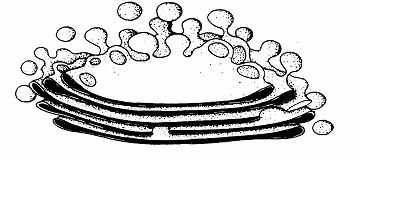The Anatomy and Physiology of Animals/The Cell Worksheet/Cell Worksheet Answers
From WikiEducator
The correct answers are shown in italics
1. The cell is divided into 3 main parts. These are:
- i. The plasma membrane
- ii. The nucleus
- iii. The cytoplasm
2. Two principal molecules make up the plasma membrane. These are:
- i. Proteins
- ii. Phospholipids
3. The Cytoplasm is: (Choose the correct option)
- The fluid within the nucleus
- The fluid around the nucleus plus the organelles
- The fluid around the nucleus minus the organelles
- The fluid surrounding the cell
4. The cytosol contains: (Circle the correct options)
- water
- proteins
- salts
- enzymes
- fats
- sodium ions
- iron ions
- amino acids
- the plasma membrane
- glucose
- starch
- DNA
- oxygen
- carbon dioxide
- hydrogen
5. Label the parts of the cell in the diagram below.
Use the labels: Nucleus, Plasma membrane, Cytosol, Nuclear membrane, Ribosomes, Rough Endoplasmic Reticulum, Smooth Endoplasmic Reticulum, Golgi body, Mitochondrion, Lysosome, Centrioles, Nucleolus
6. a. What is this organelle called? A Golgi body, the Golgi complex or the Golgi apparatus
- b. What does it do in the cell? It processes, sorts, packages and delivers proteins to the plasma membrane and lysosomes
7. a. What is this organelle called? A mitochondrion
- b. What is its function in the cell? It produces the energy for the cellular processes by cellular respiration in which glucose (or fats and sometimes proteins) are broken down in the presence of oxygen to form energy (and carbon dioxide and water)
8. Match the structure with its function in the table below.
| Structure | Function |
|---|---|
| A. Plasma membrane | c. Controlling what enters and leaves the cell |
| B. Golgi body | d. Modifying, enclosing and dispatching proteins |
| C. Lysosome | e. Breaking down and recycling bacteria and worn out organelles |
| D. Nucleus | i. Controlling the activities in the cell |
| E. Cytoplasm | g. Surrounding the nucleus |
| F. Centrioles | h. Organising the spindle in cell division |
| G. Smooth endoplasmic reticulum (SER) | k. Making and transporting fats |
| H. Rough endoplasmic reticulum (RER) | f. Making, storing and transporting proteins |
| I. Ribosomes | b.Making proteins from amino acids |
| J. Mitochondrion | a. Producing energy |
9. True or false?
- a. The cytosol consists mainly of water. T / F
- b. Ribosomes are found attached to the membrane of smooth endoplasmic reticulum. T / F No, ribosomes are found attached to the membranes of rough endoplasmic reticulum (RER)or free in the cytoplasm.
- c. The cytoplasm consists of the cytosol plus organelles and cell inclusions. T / F
- d. Cellular respiration takes place in the Golgi bodies. T / F No, Cellular respiration takes place in the mitochondria.
- e. The chromosomes in the nucleus consist mainly of RNA. T / F No, the chromosomes consist of the related molecule DNA. RNA is found in the nucleolus and is responsible for carrying the instructions from the DNA out into the cell.
- f. The nuclear membrane consists of two layers like the plasma membrane. T / F
- g. Proteins made in the RER move to the centrioles for processing. T / F No, the proteins move to the Golgi bodies for processing.
- h. Lysosomes contain enzymes. T / F The enzymes destroy worn out cell structures and bacteria that have entered the cell.
- i. Glycogen and fat droplets are often found in the cytosol. T / F
- j. Ribosomes join fatty acids together to make lipids. T / F No, ribosomes join amino acids together to form proteins.


